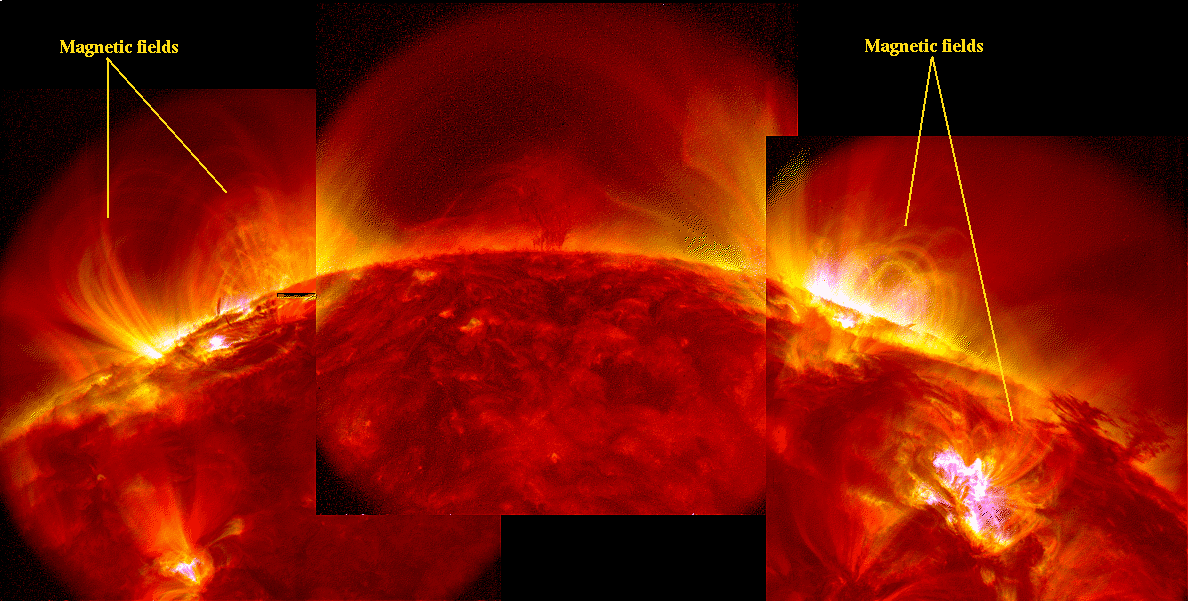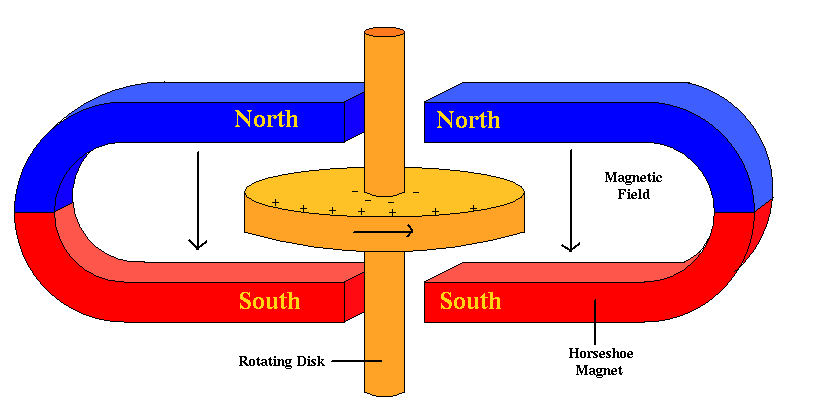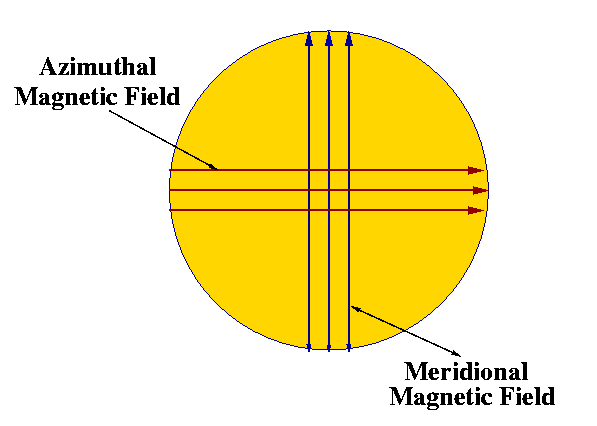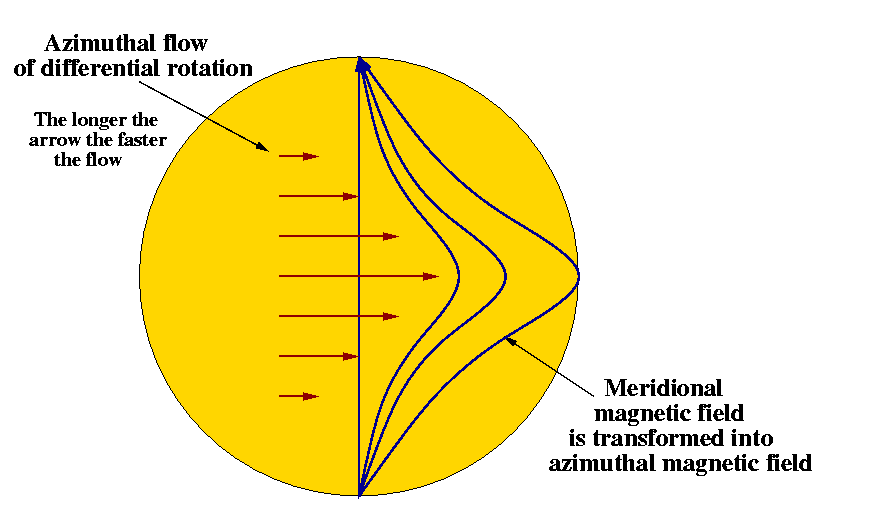

Like the Earth, the Sun has got a magnetic field . In fact, it is possible to imagine that the Sun is a big magnet, with a north pole and a south pole. However, this is a very simplified picture. If we look at the Sun more closely using satellites or telescopes, we find that the magnetic field is much more complicated. Furthermore the solar magnetic field changes constantly in time. This is shown in the following movie.
 |
 |
| |
|
The fact that the Sun has a magnetic field has only been known for about 100 years. This was discovered in 1908, by the American astronomer George Ellery Hale (1868-1938). He managed to show that sunspots are regions on the solar surface which have a very strong magnetic field. This was the first evidence of the solar magnetic field.
Sunspots are the most prominent magnetic feature on the solar surface (sometimes they can be seen by the naked eye). The number of sunspots visible on the solar surface changes fairly regularly in time. The number of sunspots increases and decreases over a period of 11 years. This is called the solar cycle. Moreover, the position of sunspots also changes in time. In 11 years, i.e. one solar cycle, sunspots move from high latitudes to the equator. By plotting the position of the sunspots versus time we obtain the so called butterfly diagrams. This behavior of the sunspots provide us with important clues on how the magnetic field behaves in space and in time. Since sunspots are regions of strong magnetic field we can conclude that the magnetic field itself has to increase and decrease in time and that the magnetic field has to move from mid-latitudes to the equator.
All these observations give rise to one big question. How does the solar magnetic field get there, i.e. how is it generated? Since the Sun is entirely made up of plasma, it is immediately clear that it cannot contain a big humongous magnet. Moreover, we also need to explain why the magnetic field changes in time and why it moves around. All these questions have not yet been fully answered. One thing that scientists agree on is that the magnetic field is generated by a mechanism called the solar dynamo and that this dynamo is also responsible for all the changes in the magnetic field.
However before we explain how the solar dynamo works, let us first have a quick look at mechanical dynamos.
The Mechanical Dynamo.A dynamo, also called an electric generator, is simply a machine that converts mechanical energy into electricity. Dynamos are most often found inside power plants. They generate the electricity you need to heat your house, to watch TV, to listen to your radio etc. The mechanical energy that powers the dynamo may be obtained from various sources as for example, wind turbines, water turbines at dams, and steam turbines.
How does it work?The simplest of all the dynamos is the disk dynamo developed by Michael Faraday (1791-1867). It consists of a copper disk mounted so that part of the disk, from the center to the edge, is between the poles of a horseshoe magnet .
 |
| |
When you start to rotate the disk electrons start to move from the center of the disk to the edge of the disk and you obtain an electrical current. The flow of electrons is possible because in metals (not unlike in a plasma) electrons are not bound to the atoms and can move around freely. This way of generating electric currents is based on a physical principal called electromagnetic induction. This principle states that if a conductor (here the rotating disc) moves through a magnetic field (here provided by the horseshoe magnet) a electric current is obtained. The law of electromagnetic induction is often referred to as Faraday's law.
However, there exists another physical principal, which says that moving electrons, i.e. electrical currents, generate magnetic fields. Physicists call this Ampere's law after the French physicist Andre Marie Ampere (1775-1836). Therefore, the above disk dynamo, does not only generate electric currents but also some magnetic field. As we can see electric currents and magnetic fields are very closely related. Simply speaking we can say that electric currents generate magnetic fields and vice versa that magnetic fields generate electrical currents.
The dynamo described here is the simplest possible electric generator that can be constructed. In a real world such a dynamo might provide the electricity for the lights on your bike. The dynamos in power stations are much more complicated machines but they still work in exactly the same way as the one described above..
The Dynamo in the Sun.Today, most solar physicists believe that the solar dynamo is located either at the bottom of the convection zone or in a thin region called the overshoot zone.The overshoot zone is located between the convection zone and the radiative zone.
How does the solar dynamo work?Since there are no magnets or rotating wheels inside the Sun you probably wonder how the solar dynamo works. In order to understand how the Sun generates magnetic fields you have basically only need to remember two facts. Firstly, the convection zone consists of a plasma, i.e. a gas that contains electrically charged particles. Secondly, the plasma in the convection zone is continuously moving around. Since the plasma is moving, the charged particles are moving and we obtain electrical currents. However, electrical currents generate magnetic fields (Ampere's law), as we mentioned above. These magnetic fields in turn generate electric currents (Faraday's law) and therefore we obtain the following loop: electric current - magnetic field - electric current - magnetic field - electric current - magnetic field etc, etc. As long as this loop is not interrupted the Sun will always produce magnetic fields.
However, this is a very simplified picture of the solar dynamo. This picture does not tell you anything about the properties of the motions of the plasma. The flow of the plasma has to fulfill certain properties for the dynamo to work. These properties are:
Let us look at magnetic fields and the solar dynamo in a different way. Imagine that magnetic fields behave like rubber bands. Thus, like rubber bands, they can be made
stronger by stretching them, twisting them, and folding them back on themselves. This stretching, twisting, and folding is done by the motions of the plasma within the solar
convection zone. Now, in order for the magnetic field strength to increase the stretching, twisting and folding has to be done in exactly the right way. The motions of the
plasma have to transform the a meridional magnetic field into an azimuthal magnetic field . A meridional magnetic field is basically a field that points
from the north to south or south to north, while an azimuthal magnetic field points from east to west or vice versa. Once that has been done the flow of the plasma has to
do the opposite, i.e. transform the a azimuthal magnetic field into an meridional. So we get another loop: meridional magnetic field - azimuthal magnetic
field - meridional magnetic field - azimuthal magnetic field etc, etc. Again the Sun will produce magnetic field as long as this cycle is not interrupted.
Let us know describe how the flow of the plasma achieves this loop. Firstly, the solar differential rotation stretches the magnetic field and winds it around the Sun. This
stretching transforms an takes a meridional magnetic field and stretches it into a azimuthal magnetic field (see picture below). This only happens because the Sun rotates
faster at the equator than at the pole. If the Sun would rotate at the same rate everywhere (this is called solid body rotation) nothing would happen to the
magnetic field and the dynamo would not work. The effect of stretching the magnetic field by differential rotation is often referred to as the omega-effect.
Now that we stretched the meridional magnetic field into a azimuthal magnetic field we need to do the opposite. This is done by the alpha-effect which is due
to the interaction of convection and rotation. The alpha-effect basically takes the azimuthal magnetic field generated by the omega-effect and transforms it back into
meridional flow. Exactly how this works is at present not well understood.
This complicated stretching, twisting and folding requires a complicated flow. A simple flow, like a 1-dimensional, laminar flow, cannot do this.
 |
 |
| Meridional Fields. |
|
Many aspects concerning the solar dynamo are not well understood even today. Here are just a few problems that scientists are working on at the moment: